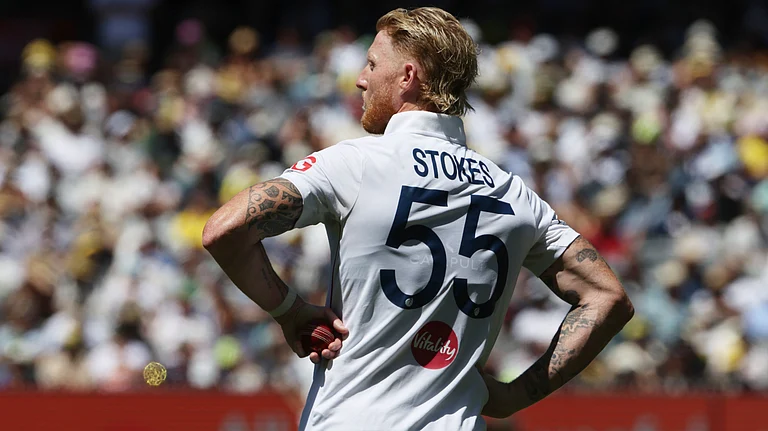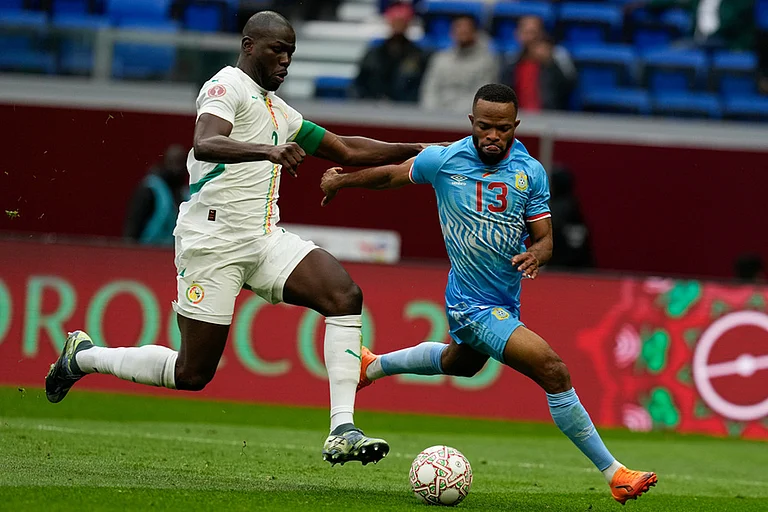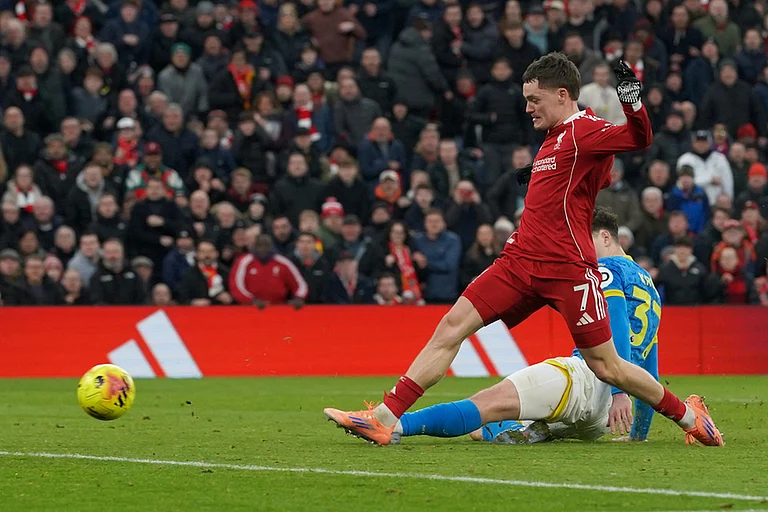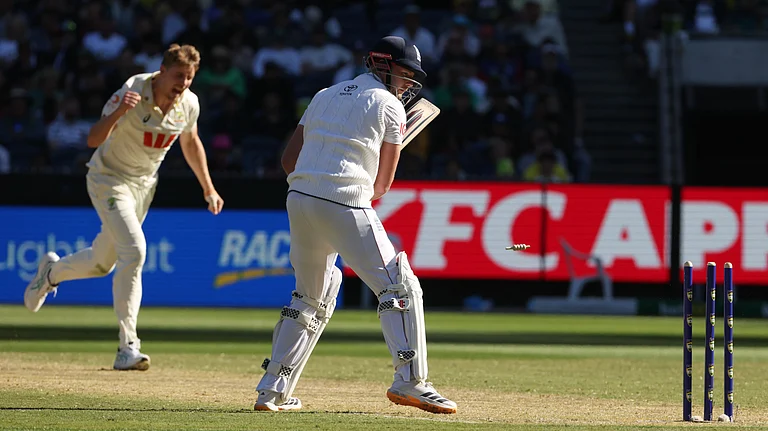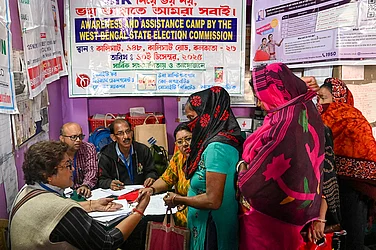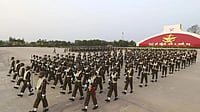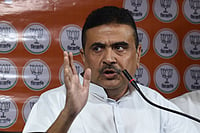AS the pace of political negotiations gets frenetic, the Congress’ hopes of forming a minority government hang in the balance. While nothing is certain in these days of shifting loyalties and convoluted calculations—party president Sonia Gandhi may yet worm her way into power if Mulayam relents—there are other options before the prospect of mid-term elections become a reality. While some of these scenarios are credible and look possible at the time of writing––such as the proposal to get Jyoti Basu to head an alternative government if the Congress can’t make it––others seem far-fetched but are backed vigorously by those whom these suit.
THIRD FRONT GOVERNMENT: Supported by the Congress and ideally led by Jyoti Basu (though former prime minister H.D. Deve Gowda is perpetually prepared to shoulder the burden). This is one way out for the "secular forces" which lined up to vote the Vajpayee government out. But Basu himself appears prevaricating—at least till all efforts to install a Congress minority regime come to naught, and anyway, his party ‘politbureaucracy’ will have the final say. The acceptability factor with Basu is high among the other Left parties, the Samajwadi Party, RJD, Janata Dal, AIADMK and Tamil Maanila Congress (TMC). Even former Third Frontwallahs like the TDP, DMK and National Conference, whom circumstances have pushed into an uneasy alliance with the BJP, may be willing to back him. Which is also the reason why the CPI(M), though not overenthusiastic, was unwilling to rule out the possibility if the Congress could not make it and even called an emergency politburo on Sunday. The problem is that even if Basu and the CPI(M) can be persuaded, who will this prospective front comprise of? The AIADMK and DMK (also TMC) cannot be in the same front. Ditto a section of the JD and the RJD.
The only solution is that all five parties lend support from the outside, but that would leave Basu with only 80-odd MPs in the government. That might be workable in such desperate times. However, it does not take into account the Congress reluctance to back such an arrangement—its MPs feel twice in the past three years is more than enough. The counter, of course, is that they may not have a choice. Unless they are prepared for polls. Or even the BJP’s return.
Then there is the fact that Basu will demand as watertight a commitment as possible from the Congress, probably in writing and with the President as witness. And anyway, this option is automatically negated if the Congress wants to join the government. Neither Basu nor his party is likely to countenance power-sharing with the Congress (which is why their first choice is a Congress minority government) even if the scenario of their agreeing to this option in the first place comes to pass. All things considered, however, this represents the Opposition’s best shot to save face if a Congress-led government doesn’t work out.
VAJPAYEE RECALLED: That would be the BJP’s dream come true. Advani has led an effective BJP campaign aided and abetted by the party’s supporters in the media to ensure the President cannot dismiss this possibility out of hand. Exhaustive quotes from Constitutional tomes and views of legal experts aligned to the party in favour of such a move have been widely disseminated. Three "precedents" have also been provided: first, the case of Gujarat chief minister Hitendra Desai in ’71 who was recalled by the governor after losing a confidence vote as he made up the numbers within a few days of being voted out (a "material change" in the situation). Then, the "criticism" of then President Neelam Sanjeeva Reddy for having sworn in Chaudhary Charan Singh as prime minister without the latter having the support of the House and thereby effectively replacing one caretaker prime minister (Morarji Desai, who had resigned) with another. Third, the fact that the United Front government was sworn in twice; first Gowda heading it, and after he lost a confidence vote, I.K. Gujral being sworn in as prime minister of the same coalition. Examples have also been provided of this recall option in other countries, including Italy and Nepal.
The problem for the BJP is that many experts consider this argument specious on the basis that once a government has been voted out (whether by one vote or 100) the options for an alternative have to be explored exclusively amongst the majority which voted it out. Even those who are willing to go along with the BJP argument do point out that there has been no "material change" in the support commanded by the ruling coalition as Pramod Mahajan admitted on Friday and that all precedents provided are either at the state level or from another country. That Vajpayee has been re-elected leader of the coalition in a show of loyalty has ensured that even the Gowda-Gujral leadership change example doesn’t fit the bill.
OPPOSITION COALITION: Riddled with contradictions, this is the option which the BJP successfully used to illustrate the impossibility of an alternative government. The Janata Dal’s Ram Vilas Paswan cannot stand the RJD’s Laloo Prasad Yadav. The TMC won’t cohabit with the AIADMK. The Left will only lend outside support. The BSP’s Mayawati and Mulayam Singh Yadav of the Samajwadi Party wouldn’t be caught dead in a ditch together. And the Congress will tear itself apart on the leadership question as Sonia may not want to lead this rag-tag outfit and nearly every other leader in the Congress would be only too glad to. This option—even as a last resort to keep the BJP out and prevent fresh elections—can only work, and just about, if sworn enemies opt to stay out of the coalition. However, that doesn’t suit many and parties such as the BSP and RSP have already said that they would prefer an election rather than support the Congress (or the BJP). On the issue of the composition of a prospective coalition or who will lead it, the differences appear irreconcilable.
FOURTH FRONT: Chandra Shekhar, Fernandes, Mulayam, Hegde (ably encouraged by the Shekhawats and Govind-acharyas) joining together in a grand anti-Congress socialist alliance, their Lohiaite credentials unimpaired, supported from the outside by the BJP. Or all those MPs who do not want a poll. Or several other possible and some improbable combinations. A balloon floated essentially to ensure that Mulayam doesn’t back the Congress in its bid to form a minority government and to ensure that "that woman" doesn’t make it to PM. Not that Mulayam could ever think of taking the BJP’s support. Or the BJP prefers this option to a poll in which they can flog the sympathy-for-Vajpayee factor. A front which allegedly found common ground on economic policy—swadeshi. The line sought to be pushed: it wasn’t December 6, 1992, which was the turning point in contemporary Indian politics (though the destruction of the Babri Masjid was a reprehensible act), but June-July 1991 when Manmohan Singh presented the first liberalisation-inspired budget. And why is this option listed here? Because the outlandish has acquired a veneer of legitimacy today.
NATIONAL (CARETAKER) GOVERNMENT: An option that finds peripheral mention if no government can be formed and the Election Commission insists that polls are not possible before September. Headed by the Vice-President (suggests Paswan) with all parties represented in Cabinet. It has no precedent, but friends of the BJP who are pushing the we-are-a-young-democracy line and that precedents can be set by an innovative President to get Vajpayee recalled, should have no objection. An extreme case and it is the President’s call.
MID-TERM POLLS: Considering the above options, probably the only solution.







